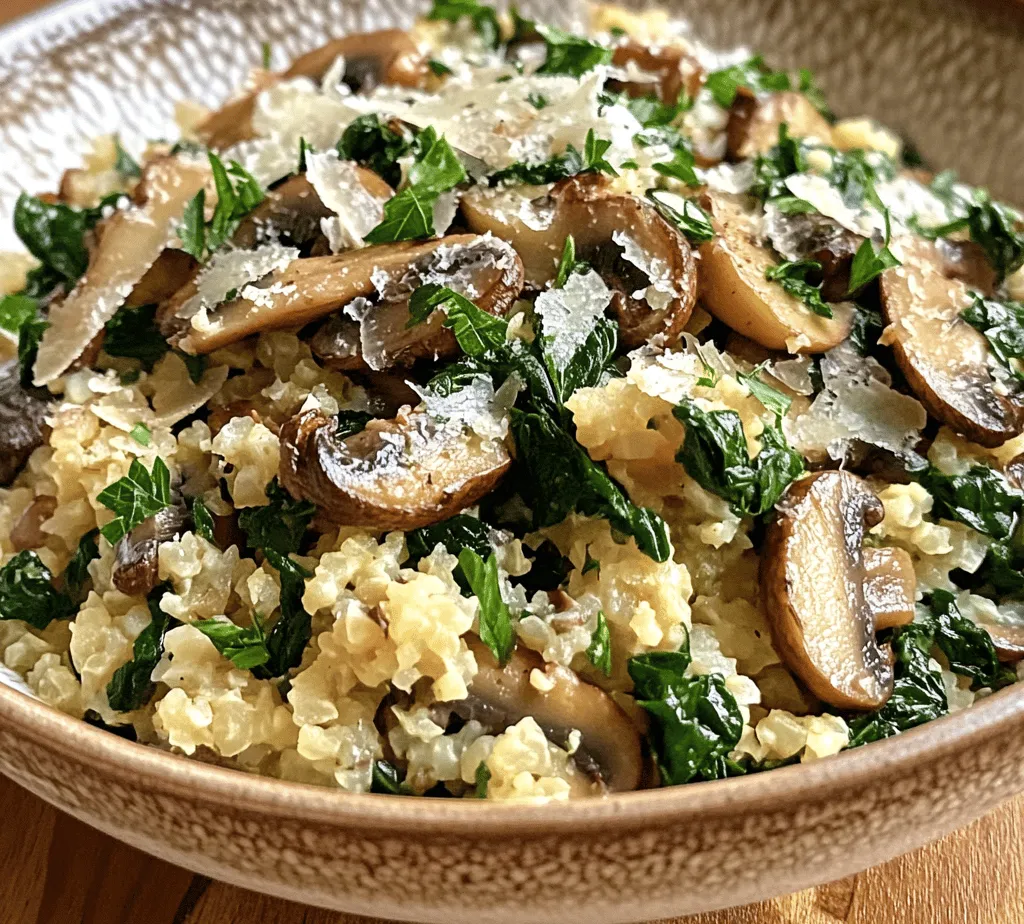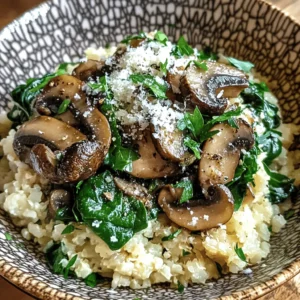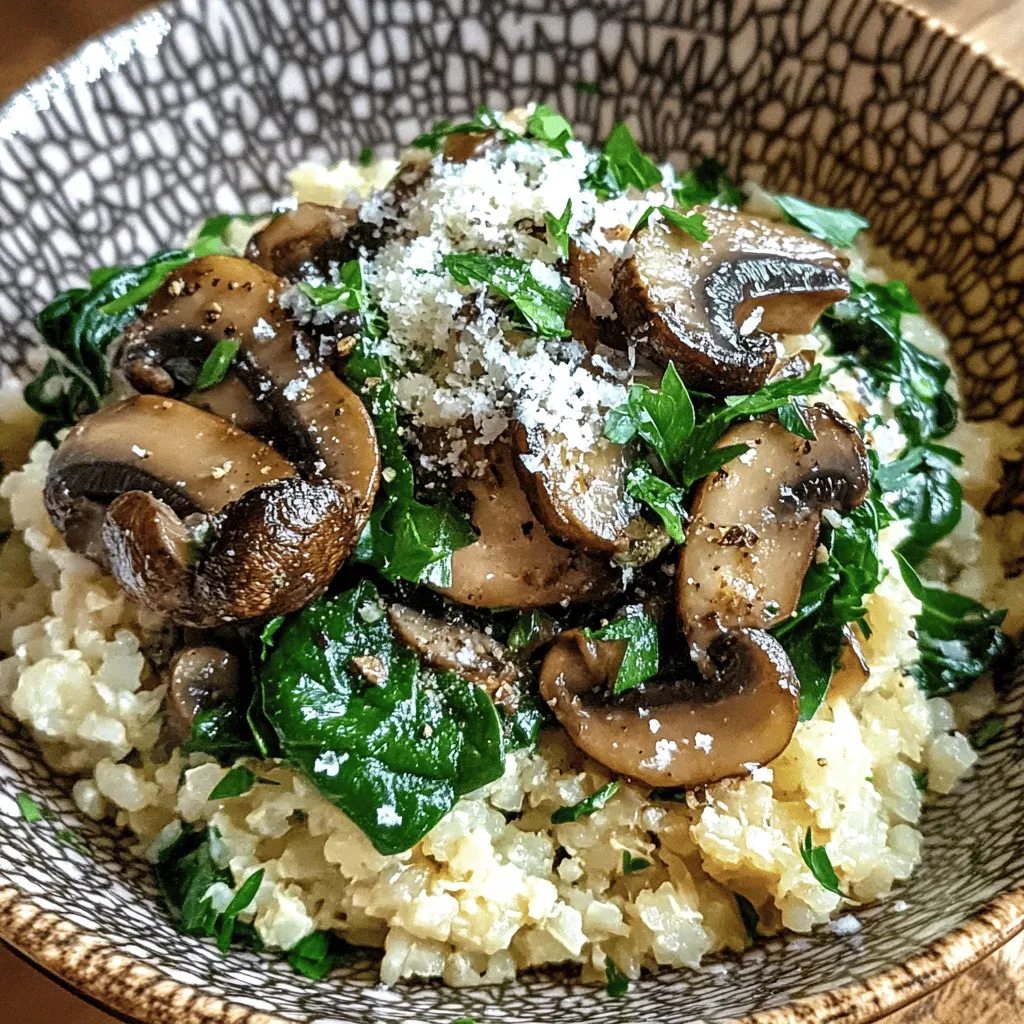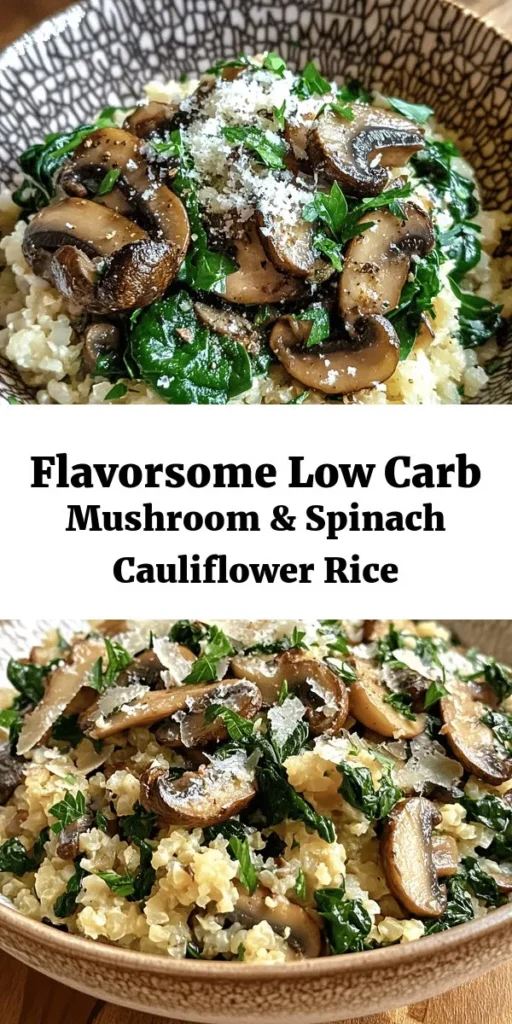Introduction
In recent years, low-carb diets have surged in popularity as individuals seek healthier lifestyles and weight management solutions. These diets emphasize the reduction of carbohydrate intake while encouraging the consumption of healthy fats and proteins. Among the myriad of low-carb alternatives, cauliflower rice has emerged as a standout option, gaining traction for its versatility and health benefits.
Cauliflower rice is not only an excellent substitute for traditional grains, but it also packs a punch nutritionally. This dish presents a delicious way to enjoy the benefits of cauliflower while incorporating nutrient-dense ingredients like mushrooms and spinach. The result is a flavorful, satisfying meal that caters to various dietary preferences, including keto, paleo, and vegan lifestyles.
This Low Carb Mushroom & Spinach Cauliflower Rice recipe is a perfect harmony of taste and health, making it an ideal choice for anyone looking to enjoy a hearty dish without the excess carbohydrates. Packed with vitamins, minerals, and a medley of flavors, it’s sure to impress even the most discerning palates. Let’s delve deeper into the ingredients that make this dish not only appealing but also a powerhouse of nutrition.
Understanding the Ingredients
Cauliflower
Cauliflower serves as the star ingredient in this recipe, providing the base for our “rice.” This cruciferous vegetable is celebrated for its remarkable nutritional profile. One of the key benefits of cauliflower is its low carbohydrate content, making it an excellent choice for those monitoring their carb intake. A one-cup serving of cauliflower rice contains approximately 5 grams of carbohydrates compared to about 45 grams in a cup of traditional white rice.
Moreover, cauliflower is rich in vitamins C, K, and B6, as well as fiber, which aids digestion and promotes a healthy gut. Its high antioxidant content also helps combat inflammation and reduce the risk of chronic diseases. With its mild flavor, cauliflower readily absorbs seasonings and complements the dish’s other ingredients beautifully.
Spinach
Spinach is another powerhouse in this recipe, loaded with essential vitamins and minerals. This leafy green is an exceptional source of vitamin A, vitamin C, vitamin K, iron, and magnesium. The health benefits of spinach are numerous; it is known for its role in promoting eye health, boosting the immune system, and enhancing skin health thanks to its high antioxidant content.
Incorporating spinach into your meals is a fantastic way to increase your vegetable intake without sacrificing flavor. In this recipe, spinach adds a vibrant color and a slightly earthy taste that balances the dish perfectly. Its nutritional density further reinforces the healthfulness of this low-carb meal.
Mushrooms
Mushrooms are not just flavorful additions to this dish; they also bring a host of health benefits. Varieties such as cremini, shiitake, and button mushrooms are commonly used in cooking, each offering unique flavors and textures. Mushrooms are low in calories but high in essential nutrients, including selenium, potassium, and antioxidants.
These fungi add a savory, umami flavor that enriches the overall dish. The incorporation of mushrooms not only enhances the taste but also contributes to the nutritional profile, providing additional fiber and nutrients while keeping the dish light and satisfying.
Olive Oil
Healthy fats are crucial in any balanced diet, and olive oil is a fantastic source of monounsaturated fats. This oil is celebrated for its heart-healthy properties and anti-inflammatory effects. Using olive oil in this recipe not only adds richness to the dish, but it also helps in the absorption of fat-soluble vitamins present in the vegetables.
Olive oil is also known for its flavor, which can vary based on its quality and type. A good quality extra virgin olive oil will impart a fruity, peppery taste that elevates the dish’s flavor profile and enhances the overall dining experience.
Garlic and Onion
Garlic and onion are essential flavor enhancers that provide depth to this recipe. Both ingredients are renowned for their health benefits, including immune-boosting properties and cardiovascular health support. Garlic is rich in allicin, a compound with potent antibacterial and antiviral properties, while onions provide quercetin, an antioxidant that helps reduce inflammation.
When sautéed, garlic and onion create a fragrant base that sets the stage for the other ingredients, enriching the dish with their aromatic qualities. Their natural sweetness balances the earthiness of the spinach and mushrooms, creating a harmonious flavor combination.
Seasonings
The seasonings in this recipe—salt, pepper, and Italian seasoning—play a critical role in bringing out the flavors of each ingredient. Salt enhances natural flavors, while freshly cracked black pepper adds a hint of heat and complexity. Italian seasoning, a blend of herbs such as basil, oregano, and thyme, provides a fragrant and robust flavor that complements the dish beautifully.
Optional Ingredients
For those looking to elevate their Low Carb Mushroom & Spinach Cauliflower Rice even further, consider adding grated Parmesan cheese as a garnish. This cheese adds a delightful creaminess and salty flavor that pairs well with the earthiness of the mushrooms and spinach. Additionally, fresh parsley can be sprinkled on top for a burst of color and freshness, making the dish visually appealing and adding a hint of herbal flavor.
The Health Benefits of Low Carb Mushroom & Spinach Cauliflower Rice
Adopting a low-carb diet can yield numerous health benefits, particularly for individuals aiming to lose weight or manage blood sugar levels. By reducing carbohydrate intake, the body shifts its energy source from glucose to fat, which can lead to weight loss and improved metabolic health. This dish, featuring cauliflower as the primary ingredient, fits seamlessly into a low-carb lifestyle, offering both satisfaction and nourishment.
The inclusion of vegetables such as spinach and mushrooms further enhances the healthfulness of this meal. Spinach provides essential vitamins and minerals that contribute to overall well-being, while mushrooms offer antioxidants that support immune function. By combining these ingredients, this recipe not only supports weight loss but also ensures sustained energy levels throughout the day.
By integrating nutrient-rich, low-carb ingredients into your meals, you can enjoy delicious flavors while supporting your health goals. The Low Carb Mushroom & Spinach Cauliflower Rice recipe exemplifies this approach, delivering a balanced, satisfying dish that is as wholesome as it is tasty.
Step-by-Step Preparation Guide
Preparing the Cauliflower Rice
The first step in creating this delectable dish is preparing the cauliflower rice. Begin by selecting a fresh head of cauliflower. Look for heads that are firm and free from blemishes. Once you have your cauliflower, follow these steps to transform it into rice:
1. Wash and Trim: Start by washing the cauliflower under cold water to remove any dirt or impurities. Next, remove the leaves and stem, cutting the cauliflower into smaller florets for easier processing.
2. Rice the Cauliflower: Using a food processor, pulse the cauliflower florets in batches until they reach a rice-like consistency. Be careful not to over-process, as this can turn the cauliflower mushy. If you don’t have a food processor, you can use a box grater to manually grate the cauliflower into rice-sized pieces.
3. Sauté the Cauliflower Rice: In a large skillet, heat a drizzle of olive oil over medium heat. Add the riced cauliflower to the skillet and sauté for about 5-7 minutes, stirring frequently, until it becomes tender and slightly golden. Season with a pinch of salt and pepper to taste. Once cooked, set the cauliflower rice aside while you prepare the other components of the dish.
With the cauliflower rice prepared, you are well on your way to creating a delicious, low-carb meal that is both satisfying and packed with nutrients. In the next section, we will continue with the detailed instructions on how to bring all the ingredients together to create this remarkable dish. Stay tuned for the next steps!

Techniques for Grating Cauliflower
When it comes to preparing cauliflower rice, achieving the right texture is key. There are two popular methods for grating cauliflower: using a box grater or a food processor.
Box Grater: This is a straightforward method that requires minimal equipment. Simply remove the leaves and stem from the cauliflower, cut it into quarters, and then use the coarse side of the grater to grate the florets. This method allows for better control over the size of the rice pieces but can be time-consuming if you’re making a large batch.
Food Processor: For a quicker, more efficient method, a food processor is the way to go. Cut the cauliflower into smaller florets and pulse them in the food processor until they reach a rice-like consistency. Be cautious not to over-process, as this can turn the cauliflower into a mushy puree rather than rice. Aim for approximately 10 to 15 pulses, checking the texture frequently.
Tips for Achieving the Perfect Rice-Sized Pieces
Regardless of the method you choose, there are a few tips to keep in mind for achieving the perfect rice-sized pieces:
1. Uniform Florets: Cut the cauliflower into uniform-sized florets to ensure even grating or processing. This helps achieve consistent rice-sized pieces.
2. Dry Cauliflower: Make sure the cauliflower is dry before grating or processing. Excess moisture can lead to soggy cauliflower rice during cooking.
3. Not Overcrowding: If using a food processor, avoid overcrowding the bowl. Work in small batches to ensure even processing.
4. Consistency Check: Regularly check the consistency of the cauliflower rice as you process. Stop when the pieces are similar in size to traditional rice grains.
Sautéing the Vegetables
The sautéing process is crucial for building flavor in your low-carb mushroom and spinach cauliflower rice. Proper cooking order and timing will ensure each vegetable retains its texture and flavor.
Cooking Order: The order in which you add ingredients to the pan significantly impacts the overall dish. Start with onions, as they require longer cooking times to soften and release their sweetness. Next, add mushrooms, which will absorb the onion flavors. Finally, toss in the spinach, which wilts quickly.
Achieving the Right Sauté Consistency:
– Onions: Sauté the onions in a bit of olive oil over medium heat for about 3-5 minutes, until they become translucent. This step is essential as it lays the flavor foundation for the entire dish.
– Mushrooms: After the onions are ready, add the sliced mushrooms. Cook them for another 5-7 minutes until they are browned and have released their moisture. If you notice they’re sticking to the pan, a splash of vegetable broth or water can help deglaze the pan.
– Spinach: Finally, add the spinach and cook for about 1-2 minutes, just until it’s wilted. This quick cooking ensures that the spinach retains its vibrant color and nutrients.
Cooking Process Overview
Now that you have your cauliflower rice prepared and your vegetables sautéed, it’s time to bring everything together.
1. Heat the Oil: In a large skillet, heat 1-2 tablespoons of olive oil over medium heat.
2. Sauté the Onions: Add diced onions and sauté for 3-5 minutes, stirring occasionally, until they are soft and translucent.
3. Add Mushrooms: Incorporate the sliced mushrooms into the pan. Stir them in and cook for about 5-7 minutes until they are browned and their moisture has evaporated.
4. Combine Cauliflower Rice: Next, add the prepared cauliflower rice to the skillet. Mix well to combine. Sauté for about 5-7 minutes, stirring occasionally. The goal is to cook the cauliflower until it’s tender yet slightly firm, mimicking the texture of traditional rice.
5. Add Seasonings: Season with salt, pepper, garlic powder, and any other preferred spices (e.g., Italian seasoning or red pepper flakes). Remember to taste as you go—adjust seasonings based on your preference.
6. Incorporate Spinach: Finally, fold in the wilted spinach and allow it to heat through for another 1-2 minutes. This step ensures that all ingredients are evenly heated.
7. Final Taste Check: Before serving, do a final taste test. Adjust seasonings if necessary, adding a squeeze of lemon juice for brightness, if desired.
Serving Suggestions
This low-carb mushroom and spinach cauliflower rice is versatile and can be served in various ways:
– Pair with Proteins: For a complete meal, consider pairing this dish with grilled proteins such as chicken, fish, or tofu. The savory flavors of the cauliflower rice complement these proteins beautifully, making for a satisfying dinner.
– Main Dish or Side Dish: This dish can serve as a hearty main course or a delightful side dish. When served as a side, it pairs exceptionally well with roasted vegetables or a fresh salad.
– Cuisine Adaptations: Get creative with flavors by adapting the dish to different cuisines. For example, you can turn it into an Asian-inspired stir-fry by adding soy sauce, sesame oil, and a mix of your favorite vegetables such as bell peppers and snap peas. Alternatively, consider a Mediterranean twist with olives, feta cheese, and fresh herbs.
Nutritional Information
Understanding the nutritional benefits of this dish can further motivate you to incorporate it into your meal planning.
– Nutritional Breakdown (per serving):
– Calories: Approximately 120
– Carbohydrates: 7g
– Protein: 4g
– Fat: 8g
– Fiber: 3g
– Comparison to Traditional Rice: In comparison to traditional rice, which typically contains about 200 calories and 45g of carbohydrates per cup, this cauliflower rice alternative is significantly lower in calories and carbs, making it an excellent choice for those following low-carb or ketogenic diets.
– Dietary Modifications: Depending on your dietary needs, you can modify the ingredient quantities. For instance, if you’re looking to increase protein content, consider adding a source of protein like cooked lentils or chickpeas.
Conclusion
In conclusion, the low-carb mushroom and spinach cauliflower rice is not only a delicious alternative to traditional rice but also a nutritious addition to any meal. With its vibrant flavors and versatile serving options, this dish is perfect for those pursuing a healthier lifestyle without sacrificing taste.
Embracing low-carb recipes like this one can help you enjoy satisfying meals while reaping the benefits of lower carbohydrate intake. By incorporating such dishes into your daily meal planning, you can maintain a balanced diet that prioritizes health without compromising on flavor. Enjoy the journey of creating nutritious and delightful meals that you and your loved ones will cherish.



